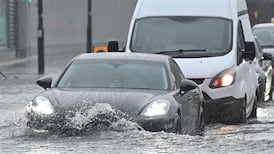Killer bees, serious potholes and snakes were part of the challenge on the plant collecting expedition, writes Dick Ahlstrom
The team were ready for snakes, prepared for spiders and mosquitoes, but hadn't expected to run into a hive of killer bees. Then there were the potholes large enough to swallow a jeep. Such are the delights of an expedition to the South American rainforest.
A year ago, Science Today spoke to a fourth-year botany student at Trinity College, Sarah Cahalane, about her impending trip to the Iwokrama International Reserve in Guyana. The reserve is part of the vast Amazonian rainforest and held the promise of new plant discoveries for those willing to make the journey.
She didn't mind the heat or the snakes, but admitted before she left to a dread of the spiders she might encounter on her trip. These she met by the dozens, but they didn't detract from her experiences in Guyana.
"It was wonderful," she says. "I didn't want to come home. It was an experience of a lifetime. It was amazing to be there and to be able to look and see these things in their natural habitat," she added. "You're thinking all the time, I could find a new plant and name it. The time was way too short. I always knew botany would be a good subject, but this was a bonus."
The long flight to Georgetown was only the beginning, and after a few days of adjustment, the team, which totalled almost 40, set out overland for the rainforest. They travelled in 4X4s for eight hours, then took to boats on the Essequibo River to reach the research station.
The impressive potholes that grace the roads of Connamara are as nothing compared to the mammoth excavations along the back roads of Guyana. The openings were often as wide as the entire roadway and as far across as a large sitting room, says Cahalane. They were usually filled with water and so their depths were a hidden risk.
The drivers would usually have to get out and wade through to find which side might be the shallower and to see if the jeep could pass without getting stuck. Then there was the descent into and climb out of the pit. "The water was coming over the bonnet half the time," she says.
Her great dread was the spiders, and they came in all sizes and colours. They often sat in webs spun across the pathway and you might look down and see four or five walking up your trouser leg, she says. "I learned how to cope with them."
The base camp had one large building for eating, botanical work and relaxing, and there were huts for sleeping. "There were quite a lot of snakes, and we managed to see one tarantula."
Most of the snakes were no problem, but one, the labaria, was a genuine danger. Everyone carried torches when heading for the huts at night to make certain they could avoid any labaria they might surprise on the way.
The biting mosquitoes and midge-like insects were a major problem for some, but insect repellent helped keep them at bay. Repellent would not have helped, however, when the team discovered that one of the trees being examined for "air plants" also carried a nest of killer bees. The bees had killed two people in Guyana a few weeks before the expedition.
Forest rangers familiar with local dangers accompanied the group and told them not to get too close. The rangers also helped with the botanical work, says Cahalane.
"The rangers knew all about the forest. We knew the botanical names, and they knew all the local names." They could also help scout for particular plants and could spot snakes and other risks quicker than the Irish visitors.
Dr Trevor Hodkinson, lecturer in botany and one of the group leaders, described free-time activities for the expedition members. There was swimming and canoeing in the Essequibo, walking trails, playing football with the rangers and sometimes just sleeping in hammocks.
The evenings were spent sorting, pressing and identifying the plant collections, searching for nocturnal caimans, boas, toads and tree frogs and occasionally enjoying a drop of Demerara rum.
Cahalane still has a problem with spiders, but would strike out on the next available expedition to the rainforest. She completes her undergraduate studies this year and is now considering whether to pursue a postgraduate degree or find a job that allows her to use her skills as a botany graduate.









